July 2022
New publication in Earth System Dynamics by Vaittinada Ayar et al. (2022) shows contrasting pattern in the projected sea-air CO2 fluxes in the tropical Pacific under future climate change. They show that about half of CMIP6 models simulate considerably bias in the interior alkalinity, which leads to bias in the upwelled watermass buffer capacity. The study cautions the importance of correctly reproducing interior biogeochemistry in accurately project future climate change.
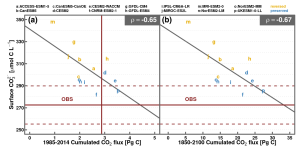
Figure 1. Projected cumulated sea-air CO2 fluxes in the tropical Pacific vs surface carbonate ion concentration over the (left) contemporary and (right) 1850-2100 period, adapted from Vaittinada Ayar et al. (2022).
January 2022
New publication in Nature Communication by Bourgeois et al. (2022) reveals that state-of-the-art Earth system models simulate a large spread in the future ocean uptake of excess heat and anthropogenic carbon. These large uncertainties are strongly linked to the water column stability or stratification in the models.
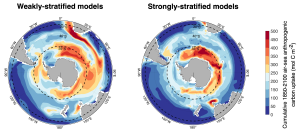
Figure 1. Cumulative anthropogenic carbon uptake in (left) weakly-stratified and (right) strongly-stratified models, adapted from Bourgeois et al. (2022).
The paper demonstrates that through the application of emergent constraint concept, a more reliable estimate with reduced uncertainty can be achieved. This constrain is robust across two generations of Earth system model ensembles, highlighting the importance of representing physical dynamic in the Southern Ocean to improve projection of anthropogenic climate change.
May 2021
The project welcome our latest postdoc, Damien Couespel,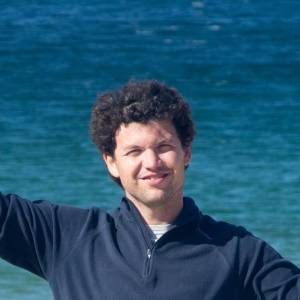 who received his PhD from Sorbonne University in Paris, France under the supervision of Marina Levy and Laurent Bopp. He is a skilled ocean biogeochemist with experiences in analyzing Earth system model outputs. His latest research before coming to Bergen focused on understanding the impact of high resolution on the projected ocean primary production. Damien starts on 19.04.2021.
who received his PhD from Sorbonne University in Paris, France under the supervision of Marina Levy and Laurent Bopp. He is a skilled ocean biogeochemist with experiences in analyzing Earth system model outputs. His latest research before coming to Bergen focused on understanding the impact of high resolution on the projected ocean primary production. Damien starts on 19.04.2021.
January 2021
The project has just crossed the mid-point and we are keen to look what exciting new results will come up in the second half. Despite the current COVID-19 situation, the project team met early in 2021 to review what we have achieved in the first half of the project, evaluate progress and make concrete plans for the future. The meeting was held online and attended by all scientific team members in the project.
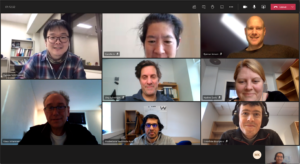
October 2020
Mendel’s peas and a rectangle in a sea of CO2
On a computer screen in Bergen, Nadine Goris sees 
 the North Atlantic engulf CO2. Just across the street, Klaus Johannsen develops methods for analyzing big data. In the garden of an Austrian monastery, Gregor Mendel cultivated pea plants. What do they all have in common? Read their stories here.
the North Atlantic engulf CO2. Just across the street, Klaus Johannsen develops methods for analyzing big data. In the garden of an Austrian monastery, Gregor Mendel cultivated pea plants. What do they all have in common? Read their stories here.
October 2020
On the 13th of October 2020, the British embassy in  Norway (Oslo) holds its annual “Science Day“, and the theme this year is “AI in the fight against climate change”. Our project member, Klaus Johannsen, was invited to give a presentation and he talked about “Understanding Climate Change: Where can Machine Learning help?”.
Norway (Oslo) holds its annual “Science Day“, and the theme this year is “AI in the fight against climate change”. Our project member, Klaus Johannsen, was invited to give a presentation and he talked about “Understanding Climate Change: Where can Machine Learning help?”.
Abstract of the talk: Climate change is one of the big challenges we are currently facing, and climate models are very important means to understand its dynamics. In this presentation we show, how artificial intelligence and machine learning can contribute to a deeper understanding of climate dynamics. Two examples are given related to the CO2 absorption into the ocean. In the first a genetic algorithm is used to determine an optimal ellipsoidal region in the ocean for constraint optimization. In the second, parameter importances are analyzed using permutation feature importance to show the geographic structure of CO2-absorption dependencies on parameters like sea surface temperature, dissolved carbon or surface wind. With these two examples it is demonstrated that important insights can be gained from intelligent data postprocessing.
September 2020
The project welcomes another new member, Pradeebane Vaittinada Ayar. He will be working on WP4 to determine the evolution of oceanic carbon/heat uptakes in the Pacific by applying different clustering schemes. Vaittinada Ayar has experiences in statistical analysis/modelling related to machine learning and particularly in clustering and regression-based spatial modelling or statistical downscaling. His past research focused on understanding the impacts of the present and future anthropogenic climate change on the hydro-climatology using and/or simulating climate variables at regional scale. His interests also extend to the analysis of large-scale atmospheric patterns to hydrological applications for small catchments.
April 2020
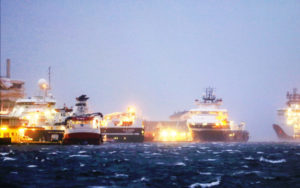
Marine science is rapidly entering the digital age. Expansions in the scope and scale of ocean observations, as well as automated sampling and ‘smart sensors’, are leading to a continuous flood of data. In collaboration with the European Marine Board, Jerry Tjiputra, together with European marine scientists, authored the Future Science Brief on ‘Big Data in Marine Science’. The document identifies bottlenecks and opportunities related to data acquisition, data handling and management, computing infrastructures and interoperability, data sharing, big data analytics, data validation, and training and collaboration.
October 2019
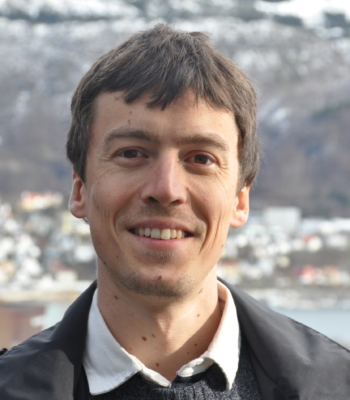
The project welcomes a new member, Timothee Bourgeois, who will contribute to the project in constraining the spread of oceanic carbon and heat uptakes in CMIP5 and CMIP6 models. He has background in regional and global impacts of the present and future anthropogenic climate change on the ocean biogeochemistry using a range of models from regional ocean-only configurations to global Earth system models. He will also contribute to the EU project COMFORT in assessing the robustness of climate model projections with respect to thresholds and tipping points linked to the ocean biogeochemistry like oxygen and pH; investigate the ocean biogeochemical implications of the climate feedbacks and their uncertainties under mitigation scenarios.
